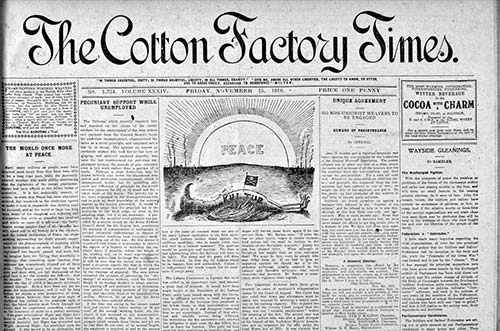Local History Society Report
Lloyd George, Spanish Flu, and the 1918 General Election in the Calder Valley
Speaker: Alan Fowler
Friday, 19 March 2021
Details of the talks programme, publications and of archive opening times are available on the Local History Society website and you can also follow the Facebook page.
With thanks to Sheila Graham for this report
In 1918, during the final months of the war, Lloyd George was already planning to fight a General Election as ‘the man who won the war.’ As Alan Fowler, former lecturer in economic and social history at Manchester Metropolitan University, explained to a Zoom meeting of Hebden Bridge Local History Society, things did not turn out quite as he planned.

Lloyd George visited Manchester in September 1918, to accept the honour of Freeman of the City and intending to kick start a campaign, but he was taken ill and forced to spend a week in the Mayor’s parlour, with no mention that he was a victim of the ‘Spanish’ flu that was sweeping the country. (As Alan pointed out, this pandemic only gained its name because Spain was not involved in fighting a war, and hence had not censored press reports of the outbreak. The scale of the epidemic was not made public until later, when after the third wave the number of British dead reached 250,000.)
In 1916, Lloyd George had broken with Asquith, leader of the Liberal party, and formed a coalition government which included Conservative and Labour support. He intended to capitalise on the peace to run for election as leader of the coalition, but during the course of the campaign things changed. The Liberal party was seriously split, with those who supported the coalition receiving ‘coupons’ to show that they were endorsed by Lloyd George.
The old order was changing, with an extension of the franchise to all men over 21 and women over 30 who owned property.
The constituency of the Calder Valley – Sowerby, Hebden Bridge and Todmorden – had returned a Liberal MP consistently, sometimes unopposed. The combination of widespread religious non-conformity, the Co-operative movement and the free trade principles of the cotton trade all fed into the Liberal tradition. The sitting Liberal MP was John Sharp Higham, a supporter of Free Trade and friend of Lloyd George. The Conservative candidate was Algernon Simpson-Hinchliffe, who had married the rich widowed heiress Helen Hinchliffe of Cragg Hall, and had stood in previous elections. For the first time a growing Labour party also put up a candidate, John Willie Ogden, a self-taught man who had risen to become president of the Amalgamated Weavers Association which had a strong presence in Todmorden. By 1918 he was president of the TUC.
Labour had distanced themselves from the Lloyd George coalition after the signing of the armistice, and would fight the election on issues of education, housing and social reform.
Higham was a supporter of the coalition and though he did not accept the ‘coupon’ which showed his colours, Hinchliffe was persuaded to withdraw in order to give him a free run. Local Conservatives were outraged and possibly nervous about the chances of Ogden, a strong local Labour candidate. They turned to a Major Robert Hewitt Barker. He was a Todmorden man of impeccable military service, in Gallipoli, the Middle East and France and stood as a representative of the National Association of Discharged Sailors and Soldiers, but was de facto an Independent Conservative.
The cotton spinners’ strike was another possible threat to the coalition, especially in a constituency like Sowerby, but Lloyd George intervened by offering a large advance of 30% and extending the settlement to the weavers as well.
Nationally, the election proved a success for the Conservatives and the few Liberals who had the Lloyd George coupon. The Asquith Liberal party was comprehensively defeated. Locally, the previous Conservative vote stayed with the Independent Barker, with very little change in support from previous years. But much of Higham’s vote shifted to Ogden, the Labour candidate. The result was a three-way split, with Higham coming bottom of the poll and Major Barker winning with only a third of the vote but a majority of 981.
Alan felt that there was little evidence that the expansion of the franchise had affected the result, and with a programme to send ballots out to the military in France, there was embarrassment that only 20% of soldiers voted. The apparent non-political candidate had won in an election of the most intense politics.
The final lecture in the current series is a change from the original programme. On Wednesday 24th March at 7.30, Jane Ellis will take us on a welcome getaway ‘Around the UK in classic railway posters.’ Jane is actively involved in the Industrial History section of the Yorkshire Archaeological and Historical Society.
See also

